
The Phrynosomatidae are a diverse family of lizards, sometimes classified as a subfamily (Phrynosomatinae), found from Panama to the extreme south of Canada. Many members of the group are adapted to life in hot, sandy deserts, although the spiny lizards prefer rocky deserts or even relatively moist forest edges, and the short-horned lizard lives in prairie or sagebrush environments. The group includes both egg-laying and viviparous species, with the latter being more common in species living at high elevations.

Phrynosoma, whose members are known as the horned lizards, horny toads, or horntoads, is a genus of North American lizards and the type genus of the family Phrynosomatidae. Their common names refer directly to their horns or to their flattened, rounded bodies, and blunt snouts.
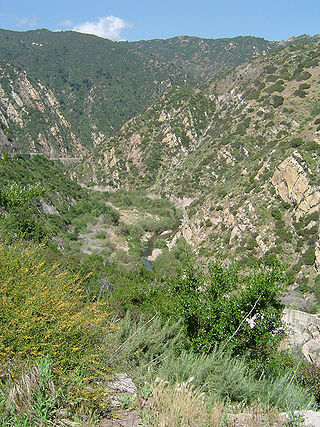
The Santa Monica Mountains is a coastal mountain range in Southern California, next to the Pacific Ocean. It is part of the Transverse Ranges. The Santa Monica Mountains National Recreation Area encompasses this mountain range. Because of its proximity to densely populated regions, it is one of the most visited natural areas in California.
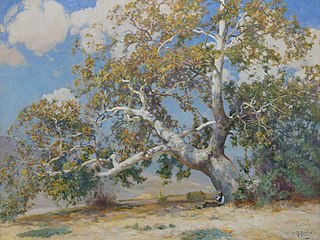
Platanus racemosa is a species of plane tree known by several common names, including California sycamore, western sycamore, California plane tree, and in North American Spanish aliso. Platanus racemosa is native to California and Baja California, where it grows in riparian areas, canyons, floodplains, at springs and seeps, and along streams and rivers in several types of habitats. It can be found as far north as Tehama and Humboldt counties.
The Santa Monica Mountains Conservancy is an agency of the state of California in the United States founded in 1980 and dedicated to the acquisition of land for preservation as open space, for wildlife and California native plants habitat Nature Preserves, and for public recreation activities.
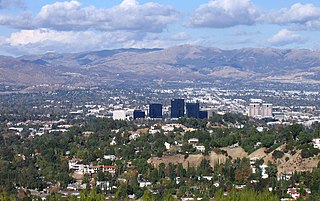
The Santa Susana Mountains are a transverse range of mountains in Southern California, north of the city of Los Angeles, in the United States. The range runs east-west, separating the San Fernando and Simi valleys on its south from the Santa Clara River Valley to the north and the Santa Clarita Valley to the northeast. The Oxnard Plain is to the west of the Santa Susana Mountains.
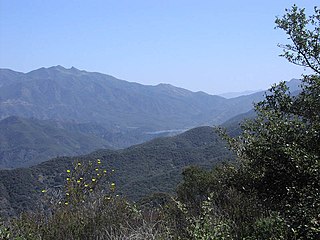
The California chaparral and woodlands is a terrestrial ecoregion of southwestern Oregon, northern, central, and southern California and northwestern Baja California (Mexico), located on the west coast of North America. It is an ecoregion of the Mediterranean forests, woodlands, and scrub biome, and part of the Nearctic realm.

The Texas horned lizard is one of about 21 North American species of spikey-bodied reptiles called horned lizards, all belonging the genus Phrynosoma. It occurs in south-central regions of the US and northeastern Mexico, as well as several isolated introduced records and populations from Southern United States. Though some populations are stable, severe population declines have occurred in many areas of Texas and Oklahoma. The Texas spiny lizard may be confused for a Texas horned lizard due to its appearance and overlapping habitat.

The desert horned lizard is a species of phrynosomatid lizard native to western North America. They are often referred to as "horny toads", although they are not toads, but lizards.

Cabrillo National Monument is at the southern tip of the Point Loma Peninsula in San Diego, California, United States. It commemorates the landing of Juan Rodríguez Cabrillo at San Diego Bay on September 28, 1542. This event marked the first time a European expedition had set foot on what later became the West Coast of the United States. The site was designated as California Historical Landmark #56 in 1932. The area was listed on the National Register of Historic Places on October 15, 1966.

The Upper Las Virgenes Canyon Open Space Preserve is a large open space nature preserve owned and operated by the Santa Monica Mountains Conservancy spanning nearly 3,000 acres (1,200 ha) in the Simi Hills of western Los Angeles County and eastern Ventura County.

The Santa Monica Mountains National Recreation Area is a United States national recreation area containing many individual parks and open space preserves, located primarily in the Santa Monica Mountains of Southern California. The SMMNRA is in the greater Los Angeles region, with two thirds of the parklands in northwest Los Angeles County, and the remaining third, including a Simi Hills extension, in southeastern Ventura County.
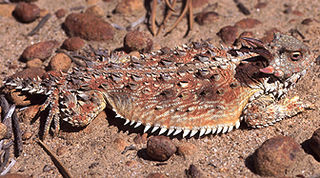
The coast horned lizard is a species of phrynosomatid lizard endemic to Baja California Sur in Mexico. As a defense the lizard can shoot high pressure streams of blood out of its eyes if threatened.

The flat-tail horned lizard is a species of lizard in the family Phrynosomatidae. A species of reptile, it is endemic to the Sonoran desert of the southwestern United States and northwestern Mexico. Its multiple adaptations for camouflage help to minimize its shadow. The species is threatened, with a restricted range under pressure from human activities such as agriculture and development, and is specially protected in the United States.

The Backbone Trail is a long-distance trail extending 67.79 miles (109.10 km) across the length of the Santa Monica Mountains in the U.S. state of California. Its western terminus is Point Mugu State Park, and its eastern terminus is Will Rogers State Historic Park in Pacific Palisades. The trail is open to hikers throughout its length. Dogs, mountain bicyclists and horseback riders are only allowed on portions of the trail as posted.

The California coastal sage and chaparral is a Mediterranean forests, woodlands, and scrub ecoregion located in southwestern California and northwestern Baja California (Mexico). It is part of the larger California chaparral and woodlands ecoregion.

Ericameria palmeri, or Palmer's goldenbush, is a North American species of flowering shrubs in the family Asteraceae. It is native to southern California in the United States and to the state of Baja California in Mexico.

Ventu Park is an unincorporated community in southern Newbury Park, California. Unlike most of Newbury Park, Ventu Park is not within the Thousand Oaks city limits. It borders Ventu Park Open Space in the north, Hidden Valley in the south, and Hope Nature Preserve in the east. It is bounded by Lynn Road to the north, Lynnview Street to the west, and Ventu Park fire lane to the south. It consists of 1,500 homes in a two square mile area. The area is known for hiking and the Los Robles Trail connects with neighboring trails that lead to the Santa Monica Mountains. Mountain biking is also popular in the area. Like the rest of Newbury Park the temperature remains temperate year-long. The region has a mild, year-round Mediterranean climate or Dry-Summer Subtropical zone climate, with warm, sunny, dry summers and cool, rainy winters. Vegetation is typical of Mediterranean environments, with chaparral and grasses on the hillsides and numerous western valley oaks. Ventu Park receives cool air from the ocean through various hill and mountain passes that creates a mild microclimate.


















